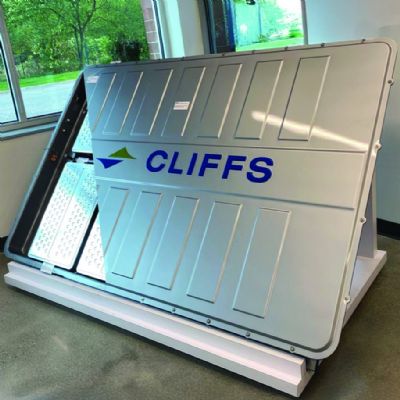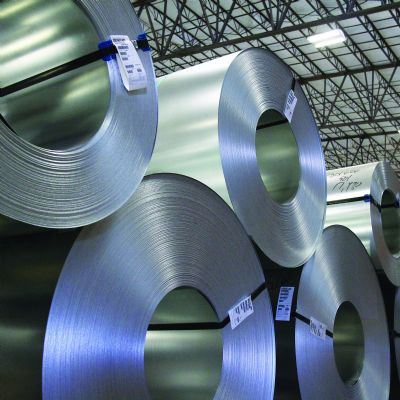Working Toward Net Zero by 2050
The World Resources Institute and the World Business Council for Sustainable Development developed the concept of Scope 1, 2 and 3 emissions as part of the Greenhouse Gas Protocol, an international set of guidelines for measuring and reporting GHG.
The Global Steel Climate Council (GSCC) formed specifically to help steel producers blaze a path that accurately counts steelmaking carbon emissions to achieve 2050 net-zero goals. In August 2023, the GSCC proposed a global steel standard to create science-based interim and long-term emissions targets “to reduce GHG emissions, helping prevent the worst impacts of climate change. Targets are considered science-based if they align with the latest climate science necessary to meet the goals of the Paris Agreement—limiting global warming to 1.5 C above pre-industrial levels,” the council states.
The council set an interim GHG reduction target of 975 kg GHGs/metric ton of steel by 2030; and a net-zero 2050 target that will result in a GHG intensity of 116 kg GHGs/metric ton of steel.
Electric-Arc Furnaces
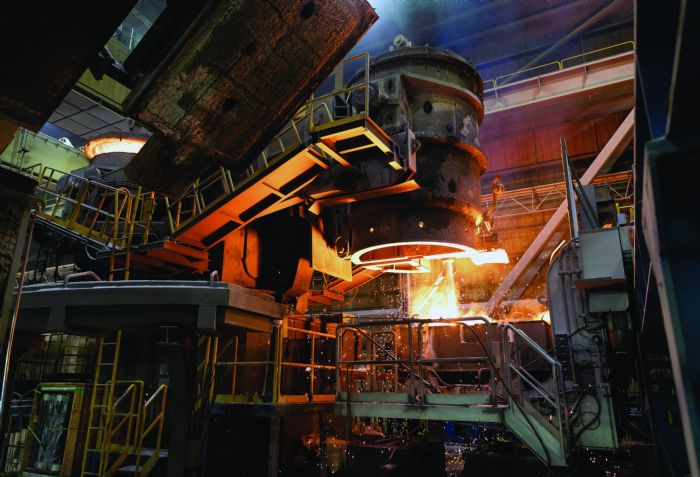 A significant step in the steel industry’s transformation was the development and use of electric-arc furnaces (EAFs). Although invented in the 19th century and first launched in the United States in 1907, it wasn’t until the 1970s that EAFs began as commercially viable alternatives to the traditional steel-making processes.
A significant step in the steel industry’s transformation was the development and use of electric-arc furnaces (EAFs). Although invented in the 19th century and first launched in the United States in 1907, it wasn’t until the 1970s that EAFs began as commercially viable alternatives to the traditional steel-making processes.
“From the time we entered the steel business more than 50 yr. ago, Nucor has been focused on producing steel sustainably,” the company states. “When our first EAF roared to life in Darlington, SC, it ushered in a new era of steelmaking in the United States and radically transformed the industry. The impact is still felt today with more than 70% of U.S. steel production coming from EAFs.”
A blast furnace (BF) uses purified coal or “coke,” limestone and extremely high-temperature heat to convert iron oxide into molten iron. The molten iron then moves into a basic oxygen furnace (BOF) to become steel. The BF-BOF process releases the highest carbon emissions of any steelmaking process—an estimated 2.1 tons of CO2 emissions/ton of crude steel.
 EAFs use an alternative energy source to coal—electricity—to melt steel, and can process scrap metal as well as direct reduced iron (DRI) and hot-briquetted iron (HBI), Nucor reports. The process reduces GHG emissions both because of the energy type used to melt the iron, and because less energy is required to melt scrap. Although the EAF process still requires large amounts of high-intensity DC and AC electricity passed through huge graphite electrodes, it releases roughly 75% lower carbon emissions than the BF-BOF process. EAFs conserve additional energy because they can be activated and deactivated quickly, whereas BF-BOFs take time to start up and shut down.
EAFs use an alternative energy source to coal—electricity—to melt steel, and can process scrap metal as well as direct reduced iron (DRI) and hot-briquetted iron (HBI), Nucor reports. The process reduces GHG emissions both because of the energy type used to melt the iron, and because less energy is required to melt scrap. Although the EAF process still requires large amounts of high-intensity DC and AC electricity passed through huge graphite electrodes, it releases roughly 75% lower carbon emissions than the BF-BOF process. EAFs conserve additional energy because they can be activated and deactivated quickly, whereas BF-BOFs take time to start up and shut down.
Recycled steel does not yet exist in sufficient volumes or grades to provide all current and future steel demand, thus using EAFs alone is not enough to achieve net-zero goals. Iron ore still must be mined and used as a raw material to produce virgin steel.
Carbon Offsets
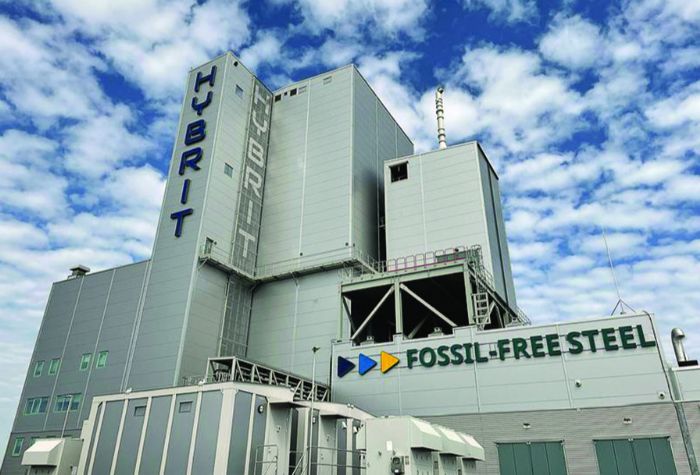 In October 2021, Nucor launched Econiq, which it calls “the world’s first net-zero carbon steel at scale, and a certified low-embodied carbon-steel solution.” The Econiq NZ steel meets Scope 1 targets by using carbon offsets. This means that although the energy generated at the source is not emissions-free, Nucor purchases renewable energy generated offsite, in effect offsetting its emissions. Econiq RE certifies that Nucor steel or steel products are made with 100% renewable energy.
In October 2021, Nucor launched Econiq, which it calls “the world’s first net-zero carbon steel at scale, and a certified low-embodied carbon-steel solution.” The Econiq NZ steel meets Scope 1 targets by using carbon offsets. This means that although the energy generated at the source is not emissions-free, Nucor purchases renewable energy generated offsite, in effect offsetting its emissions. Econiq RE certifies that Nucor steel or steel products are made with 100% renewable energy.
Sequestration
Nucor also is exploring carbon sequestration to reduce its carbon footprint. The steelmaker formed a partnership with ExxonMobil at its Louisiana direct-reduced iron (DRI) plant to remove CO2 from the DRI process and sequester it, the company says.
Non-Coking Coal and Oxygen
As an alternative to a blast furnace, ArcelorMittal uses Primetals Technologies’ Corex process that uses oxygen instead of a hot blast of nitrogen, thereby reducing NOx gas emissions. The process comprises two main parts: a reduction shaft and a melter-gasifier. The main reagents for the Corex process are iron ore, non-coking coal and oxygen—coke-making and sintering are not required. After iron ore, limestone and dolomite are added to the reduction shaft, the reduction gas reduces the ore into DRI. The DRI is redirected to the melter-gasifier for melting of the iron and slag.
Carbon Waste to Renewable Gas
 Also being explored is recycling previously wasted carbon emissions through carbon-capture technologies, ArcelorMittal states. Partnering with LanzaTech, Primetals Technologies has helped to establish a gas-fermentation “Steelanol” plant at ArcelorMittal’s facility in Gent, Belgium, that recycles blast-furnace waste gas into bioethanol. The bioethanol is used in place of fossil-sourced natural gas to power the process.
Also being explored is recycling previously wasted carbon emissions through carbon-capture technologies, ArcelorMittal states. Partnering with LanzaTech, Primetals Technologies has helped to establish a gas-fermentation “Steelanol” plant at ArcelorMittal’s facility in Gent, Belgium, that recycles blast-furnace waste gas into bioethanol. The bioethanol is used in place of fossil-sourced natural gas to power the process.
Plant Upgrades and Conversions
ArcelorMittal seeks to reduce its CO2 emissions in North America by a minimum of 25% by 2030, in line with its global company goal of carbon neutrality by 2050. In Hamilton, Ontario, Canada, it plans to convert from BOF to EAF steelmaking, for an approximate 60% reduction of GHG emissions by 2030, it reports. In Port-Cartier, Quebec, it will convert pellet production to DRI pellets by the end of 2025, reducing plant CO2 emissions by approximately 20%; and in Calvert, AL, the company is nearing completion of an EAF plant, replacing the purchase of slabs made via BF/BOF, the company reports.
ArcelorMittal North America’s XCarb recycled and renewably produced steel is guaranteed to be produced in an EAF with a minimum 70% scrap content using 100% renewable electricity such as hydro, wind and solar—and connected to the same grid as its steelmaking operations.
Integrated mill and mining company Cleveland-Cliffs says that it produces environmentally friendly iron-ore pellets and the feedstock that enables it to produce cleaner, more sustainable steel. Advancements in using DRI and HBI in place of pig iron, further reduce GHG emissions in steelmaking.
In 2020, Cliffs completed what it calls “the world’s most advanced direct-reduction facility” in Toledo, OH. The natural-gas-based plant produces HBI.
Early in 2024, the Biden administration announced as much as $1 billion in awards for two commercial-scale projects designed to demonstrate accelerated decarbonization projects in energy-intensive industries. The grants are part of a larger $6.3 billion federal program intended to cut planet-warming emissions from the production of steel and other products.
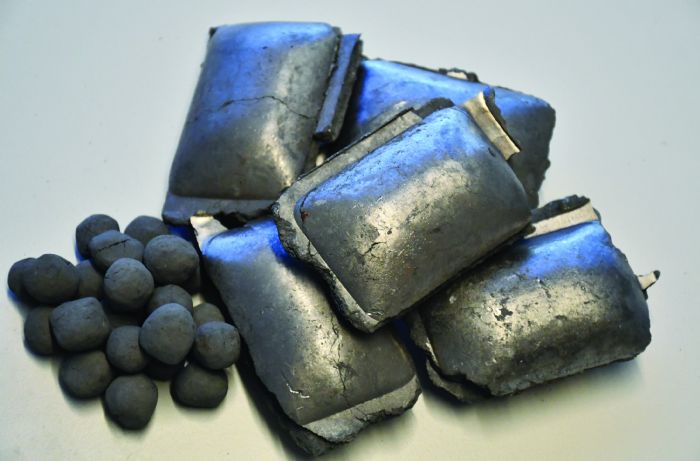 Cleveland-Cliffs was selected to receive potentially $500 million of those funds to help revamp its existing steel mill in Middletown, OH. The steelmaker plans to install a “hydrogen-ready, flex-fuel” DRI plant and two electric melting furnaces to replace the current older blast furnace.
Cleveland-Cliffs was selected to receive potentially $500 million of those funds to help revamp its existing steel mill in Middletown, OH. The steelmaker plans to install a “hydrogen-ready, flex-fuel” DRI plant and two electric melting furnaces to replace the current older blast furnace.
“This project plans to demonstrate hydrogen-based ironmaking technology while replacing one of Cleveland-Cliffs’ seven operating blast furnaces and enabling the company to further decarbonize rolled steel products for its customers in the U.S. automotive industry,” the steelmaker says.
The company will first use natural gas to remove the oxygen in iron ore in the blast furnace. The steelmaker plans to gradually replace the fossil-sourced methane with “clean hydrogen” as supplies become available. Cleveland-Cliffs pledged to supplant the DOE award with an additional $1.1 billion to finance the remainder of the project. When completed in 2030, the project would reduce an estimated 1 million tons of GHG emissions/yr.
“We are pleased to report that our Scope 1 and 2 GHG emissions intensity averages have continued on a favorable downward trend,” the company reports. “In 2023, Cliffs’ Scope 1 and 2 GHG emissions remained below our 25% reduction goal ahead of our 2030 target year.”
In addition, SSAB was in the running for $500 million to build a steelmaking plant in Mississippi also using green hydrogen under the same DOE award program, but recently has withdrawn from negotiations for the award.
Melting Iron Ore with Fossil-Free Energy
The last frontier in reaching net-zero goals is using fossil-free energy to heat, reduce and melt the iron and scrap metal at the mill, steelmakers agree.
“By changing the way that steel is produced, we want to create an entirely fossil-free value chain with customers and partners,” SSAB reports. “SSAB is revolutionizing steelmaking with two unique steels with virtually zero fossil carbon emissions—paving the way for a greener future.”
The steelmaker has developed two products—SSAB Zero, a scrap-based steel commercially available now, and SSAB Fossil-free, an iron-ore-based steel still in development.
SSAB calls SSAB Zero “the next generation of recycled steel.” It is produced with fossil-free electricity and renewable natural gas.
The steel has virtually zero fossil emissions during steel production, the steelmaker claims. Heat is generated from an electric arc between electrodes. Oxygen is blown into the furnace, and lime and slag foamers are added to combine with the impurities and form slag. Molten steel is extracted and poured out via a tapping spout. Across the entire process, only fossil-free electricity and fuels are used.
The “renewable natural gas” is biogas, also known as biomethane, produced from organic waste such as animal waste, food waste and wastewater. It is used similarly to conventional natural gas, but is not extracted, mined or fracked.
SSAB has partnered with LKAB, a state-owned Swedish mining company, and Vattenfall, a European energy company, to invent the world’s first fossil-free steelmaking technology, called Hybrit, the company says. SSAB Fossil-free steel, produced by using Hybrit technology as its energy source, is an ore-based process to produce virgin steel.
By replacing the coking coal traditionally used in iron ore-based steelmaking with fossil-free electricity and hydrogen, the process produces steel with virtually no carbon footprint. The direct reduction of iron ore is executed using fossil-free hydrogen only. The process emits water instead of CO2.
In the Hybrit process, iron ore is direct-reduced to iron ore pellets, and then to iron using only fossil-free hydrogen gas. SSAB has produced pilot batches of fossil-free steel and aims to scale up production in the coming years. The iron has a porous structure and is known as sponge iron, or DRI.
The Hybrit project has been awarded funding by the EU Innovation Fund and by Industriklivet. It is also part of the European IPCEI project Hy2Use (Hydrogen), which involves a total of 35 projects from 12 countries to support rapid transition and increase the competitiveness of the European industrial sector.
ArcelorMittal concurs that the final steps to producing green steel include eliminating carbon emissions at the source. “For DRI solutions, this means using 100% hydrogen as the reducing agent rather than natural gas,” the steelmaker explains, pointing to Primetals Technologies, which is developing Hyrex and Hyfor, using hydrogen to reduce iron ore.
In July of 2024, Primetals Technologies and Posco signed an agreement to design and implement a Hyrex demonstration plant in South Korea to test and verify details of the production process.
Hydrogen-based direct-reduction technologies based on the Hyrex process will enable steel producers to replace carbon-intensive blast furnaces, the company states.
The process combines the Finex process with an electric melting furnace. It uses hydrogen as a reducing agent instead of coal gasification. It produces liquid hot metal with similar quality to blast furnaces, but with lower carbon emissions. It can be fed with sinter feed, which removes the need for a coke plant.
Hyfor, a joint effort of Primetals, Voestalpine and Fortescue, is a direct-reduction process that doesn’t require sintering or pelletizing. It uses hydrogen to remove oxygen particles from iron oxide. It can be used to produce green pig iron from iron-ore fines.
As for Cleveland-Cliffs, it states that “we are a leader in supporting the commercial development and deployment of clean hydrogen as a decarbonization strategy for domestic iron and steel production.” The steelmaker has conducted hydrogen trials at its Middletown Works blast furnace, and Indiana Harbor blast furnace #7.
All Eyes on the Prize
All four of the steelmakers are resolute in their commitment to their climate goals.
“We aim to be part of the solution and our journey toward carbon neutral steel is well underway,” ArcelorMittal states. “This is what we believe it takes to be the steel company of the future.”
“We continue to work to reduce our carbon footprint in our facilities, in the energy we use to make our steel, and in increasing the circularity of the process,” Nucor adds. “We are a proud member of the DOE’s Better Climate Challenge.”
“One of the most important issues impacting our planet is climate change,” Cleveland-Cliffs proclaims. “We regularly track our progress against our goal of reducing combined absolute Scope 1 and 2 GHG emissions 25% by 2030.”
“Time is running out for the planet and future-focused companies need to act now if they want to be part of the solution, not the problem,” Swedish steelmaker SSAB states. MF
View Glossary of Metalforming Terms
See also: Nucor Corp.
Technologies: Management, Materials







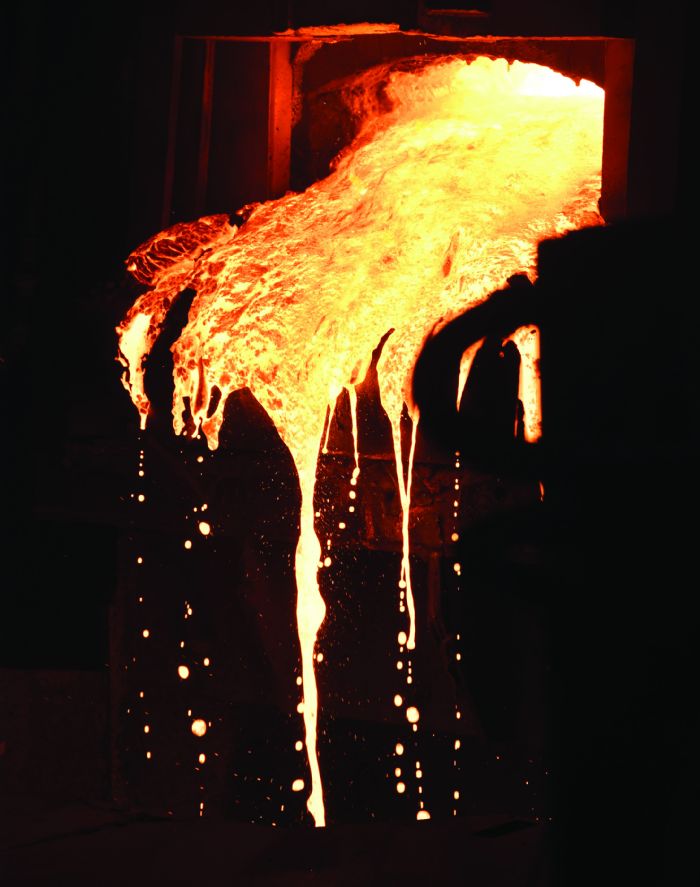 Because steel is so valuable, steel scrap also is valuable, and the steel industry long has had an established and successful reuse and recycling network. In that metric of sustainability, steel rightfully has made a solid case for heralding its achievements. Steel is 100% recyclable, and 90% is recycled, according to World AutoSteel. High marks there.
Because steel is so valuable, steel scrap also is valuable, and the steel industry long has had an established and successful reuse and recycling network. In that metric of sustainability, steel rightfully has made a solid case for heralding its achievements. Steel is 100% recyclable, and 90% is recycled, according to World AutoSteel. High marks there.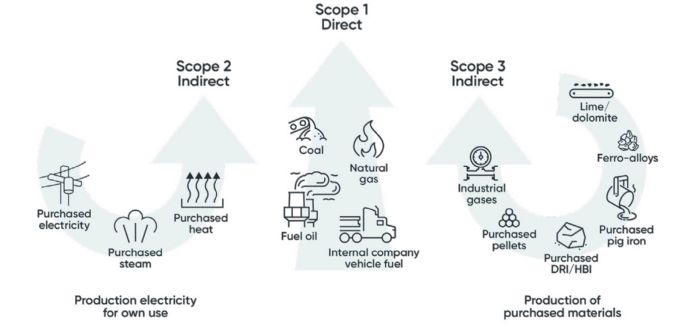 Responding to growing environmental concerns and the urgent need for sustainable steel, steel suppliers have begun to make inroads toward net-zero production. For example, steelmakers Nucor, Arcelor-Mittal, SSAB and Cleveland-Cliffs have pledged, developed strategies and made measurable progress—to achieve net-zero goals by 2050 in alignment with the Paris Climate Agreement.
Responding to growing environmental concerns and the urgent need for sustainable steel, steel suppliers have begun to make inroads toward net-zero production. For example, steelmakers Nucor, Arcelor-Mittal, SSAB and Cleveland-Cliffs have pledged, developed strategies and made measurable progress—to achieve net-zero goals by 2050 in alignment with the Paris Climate Agreement.